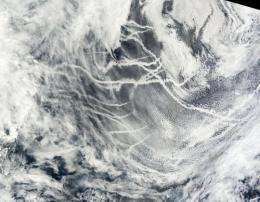The birth of a cloud droplet

(PhysOrg.com) -- Wrapped in mystery, the formation of a cloud droplet comes down to physics. Pacific Northwest National Laboratory led a research team that has helped peel away another layer of the cloud droplet conundrum. The team, led by Dr. Steven Ghan, evaluated several popular computational methods that describe how tiny particles in the atmosphere serve as seeds for cloud droplets. Their state-of-the-science study found all methods performed well under most conditions, but the more complex treatments performed well under a wider range of conditions.
Emissions of aerosols, those tiny bits of smoke, pollution, and chemicals in the atmosphere, have changed substantially over the last 200 years as a result of burning forests, coal, and other organic materials. The changes in aerosol concentration in the atmosphere affect clouds and the energy balance of the Earth, but the complexity of this influence is a large area of uncertainty for climate change prediction. At the root of this aerosol effect is how aerosols turn into cloud droplets, a process called droplet nucleation, and how they brighten clouds. Brighter clouds scatter sunlight and have a cooling effect on the Earth. Cloud droplet size and number also affects rainfall; the more droplets, the smaller they become and the less likely they are to fall out of clouds as rain. Understanding the cooling effect of brighter clouds, and the effect on rainfall, are two important parts of the climate picture.
Led by Dr. Steven Ghan, a team compared and contrasted the assumptions used in developing the most popular cloud drop nucleation parameterizations, and compared them under a variety of conditions. All imaginable conditions, such as different updrafts, amounts and sizes of aerosol and cloud conditions were used. They compared these methods against a detailed model estimate to see how they measured up against the benchmark simulations. They also compared global estimates of aerosol effects on the Earth's climate using two of the parameterizations.
Their conclusions and recommendations were published in the Journal of Advances in Modeling of Earth Systems.
The methods reviewed in this study focused on droplet formation at cloud base, the lowest altitude of a cloud. The team is now exploring methods to represent droplet formation inside clouds, where updrafts are stronger but droplet surface area, which affects the transfer of water vapor to the particles, is larger than at cloud base.
More information: Ghan SJ, et al. 2011. "Droplet Nucleation: Physically-Based Parameterizations and Comparative Evaluation." Journal of Advances in Modeling of Earth Systems, 3:M10001. DOI: 10.1029/2011MS000074.
Provided by Pacific Northwest National Laboratory





















